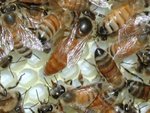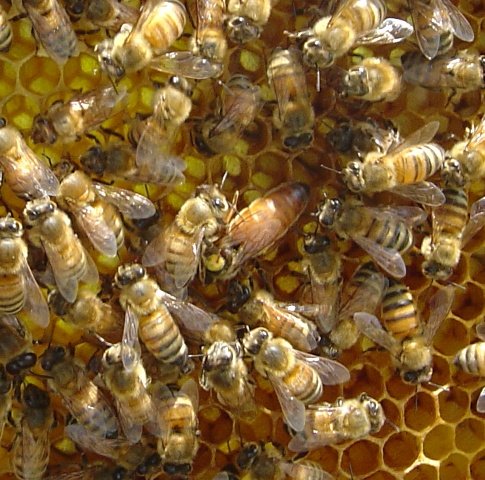http://www.facebook.com/group.php?gid=112000928841858&v=app_2373072738#!/group.php?gid=112000928841858&v=wall
Come Visit!
Last night I was informed that a fellow beekeeper had just received a shipment of queens from Hawaii.
With a quick call, and short driver over to the next town, I had two beautiful Kona Queens.
Above: Two Kona Queens From Hawaii. The blue mark indicates they are 2010 queens
Since they did not have any attendant workers in the cages with them I needed to get them into colonies as soon as possible. From what I have heard from fellow beekeepers the Kona queens have done well here on Cape Cod.
Last week’s inspections revealed that one of the hives was queen-less, while another had dwindled down to about one hundred bees.
Right: a few of our colonies. You can see the two white 5 frame nucs, just created, in the center bottom of the photo. One of these nucs contains the old queen discovered during the hive inspection. The other contains bees, eggs, and larva. They will have to raise their own queen.
As you may remember the queen-less hive is our "nasty" hive, and being queen-less did not help their attitude much. As I opened the colony I had flashbacks of the previous week’s events, and wondered if that nasty little worker bee was still waiting for me inside.
As I looked over the frames I could see that they were attempting to build queen cells, but had nothing to put in them since the hive had no queen, larva, brood or eggs. I found three empty queen cell starts.
Left: The hives are still working the dandilions.
As soon as I placed the queen and her cage on top of the frames the worker bees were all over her. I plan on letting them get to know her for a few days before I remove the cork protecting the candy in the cage. Once I remove the cork the workers will eat through the candy in a day or two and release her. I want to revisit this hive to verify that there is no laying worker before I take the chance and allow them to release her. This will provide a few additional days to help in acceptance.
Perhaps, with a new queen, this hive will settle down a bit. If the workers accept the queen she will begin to lay eggs, and the entire genetics of the colony will change over the course of two months making this hive more gentile.
I opened up the dwindling hive to look at them. Sure enough they had killed the failing queen, and in her place built five queen cells!
Right: Workers gather water for the colonies.
I destroyed the queen cells and place one of the new queens on the top bars in the colony. I will check again in about 5 days to make sure the workers have released her.
While I was out in the apiary I thought I should look in on the hive that superseded the queen from 2007. I opened the hive to find it full of eggs and young larva! The new queen is doing fine.
Guess what else I found! Sure enough, there in the top box, was the old queen, with her faded yellow marking and all!. I put her aside in a nuc box with an additional frame of bees and brood, and continued to look for the new queen. I found her in the bottom box with eggs and young larva! She has filled out since mating and is a good size.
This is the first time I have seen this. Mother and daughter queens existing in the same hive.
They have been coexisting for at least two weeks if not longer.
What a surprise!
I never know what I am going to find next!












I had a very small hive when I was a teenager and have always loved honeybees. This site is absolutely fascinating! I currently live in an apartment so can't keep bees, but this site is making me desperately want to! Keep it up, and I'll be checking back often for new updates!
ReplyDelete